
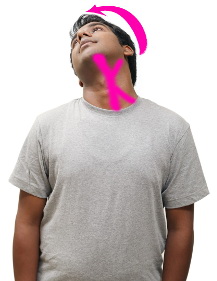
Steps for doing:
- The coloured part is being stretched.
- Keep your right hand behind your body.
- Left hand behind your head and just behind ears as shown
- Pull your head towards left and forward.
- Remember to tuck your chin towards the chest wall.
- See that head is moved in an arch-like fashion towards the left side
- Hold the same position for 10-20 seconds, without holding your breath
In this video, we are going to stretch a hyoid group of muscles The coloured part is being stretched as shown The arrow indicates the direction of stretch
- Group of muscles which helps tongue, throat, jaw to function properly
- Symptoms refer to teeth, head, jaw, tongue, throat and neck region.
- Symptoms may include pain, numbness, hypersensitivity, altered sensation and symptoms related to compression of adjacent blood vessels and nerves.
- Commonly related to diseases such as dental cavities, headache, neck pain, swallowing difficulty, tongue pain, and throat discomfort.
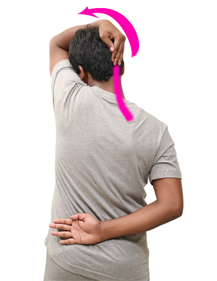
Steps for doing:
- The coloured part in being stretched.
- Keep your right hand behind your body.
- Left hand behind your head and just behind ears as shown
- Pull your head towards left and forward.
- Remember to tuck your chin towards the chest wall.
- See that head is moved in an arch-like fashion towards the left side
- Hold the same position for 10-20 seconds, without holding your breath
In this video, we are going to stretch a hyoid group of muscles The coloured part is being stretched as shown The arrow indicates the direction of stretch
- One of the important muscle responsible for a stiff neck.
- Symptoms refer to scapula, shoulder, head and neck region.
- Symptoms may include pain, numbness, hypersensitivity, altered sensation, irritability and symptoms related to compression of adjacent blood vessels and nerves.
- Commonly related to diseases such as levator scapulae syndrome, stiff neck syndrome, C3, C4, C5 or C6 spinal joint dysfunction and others.
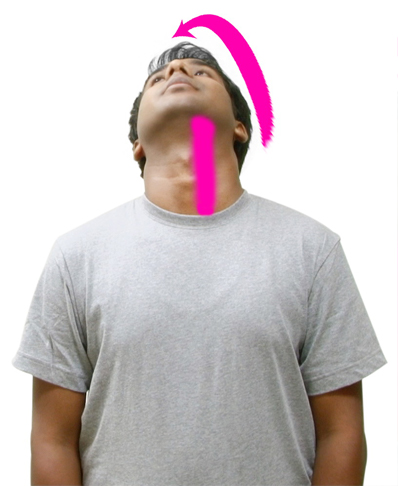
Steps for doing:
- The coloured part in being stretched.
- Neck moved opposite to that of the muscle which is being stretched.
- Neck extended posteriorly and towards right for stretching left side muscle.
- Remember to raise the chin for better stretch
- Hold the same position for 10 -20 seconds, without holding your breath
In this video, we are going to see longus colli and capitus muscle stretching exercise
The coloured part is being stretched as shown.
The arrow indicates the direction of stretch
- One of the muscle involved in stiff neck.
- Symptoms refer to neck ,head and throat regions.
- Symptoms may include pain, numbness, hypersensitivity, altered sensation,irritability and symptoms related to compression of adjacent blood vessels and nerves.
- Commonly related to disease such as sore throat, whiplash injury, neck pain, swallowing difficulties, head ache and others.
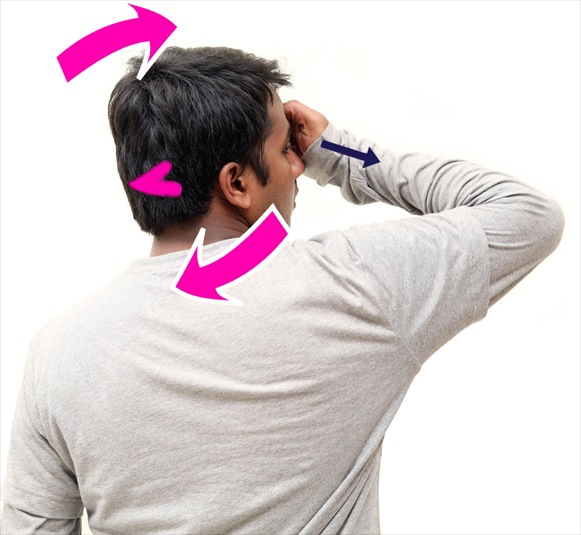
Steps for doing:
- The coloured part in being stretched.
- Hold with your right hand, behind the outer aspect of the left eye
- Turn the head towards the opposite direction.
- Push Towards right and downwards.
- Hold the same position for 10-20 seconds, without holding your breath
In this video, we are going to see the stretching exercise of suboccipital group of muscles
The coloured part is being stretched as shown (stretch over left side/but coloured part shown on the right side)
The arrow indicates the direction of stretch
- This muscle is responsible for migraine headache
- Symptoms refer to head and neck junction, head, and neck region.
- Symptoms may include pain, numbness, hypersensitivity, altered sensation, irritability and symptoms related to compression of adjacent blood vessels and nerves.
- Commonly related to diseases such as stiff neck syndrome, various headaches, and spinal joint dysfunction.
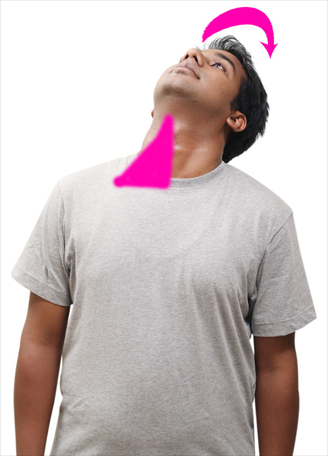
Steps for doing:
- The coloured part in being stretched.
- Neck moved opposite to that of the muscle being stretched.
- Neck extended posteriorly and towards left for stretching right side muscle.
- Remember to raise the chin for a better stretch.
- Hold the same position for 10-20 seconds, without holding your breath
In this video, we are going to see a scalene group of muscles stretching exercise
The coloured part is being stretched as shown.
The arrow indicates the direction of stretch
- The muscle responsible for upper limb weakness.
- Symptoms refer to the neck, upper limb, chest wall, and ribs.
- Symptoms may include pain, numbness, hypersensitivity, altered sensation, irritability and symptoms related to compression of adjacent blood vessels and nerves. Commonly related to diseases like scalene syndrome, cervical nerve compression, spinal joint and rib joints dysfunction.
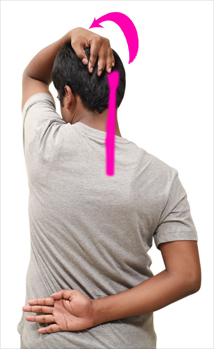
Steps for doing:
- The coloured part in being stretched.
- Keep your right hand behind your body as shown
- Hold the head with left-hand midway between ears
- Pull your head towards forward and left side in an arch-like fashion
- Remember to tuck your chin towards the chest for better stretch
- Hold the same position for 10-20 seconds, without holding your breath
In this video, we are going to stretch Semispinalis capitis muscle
The coloured part is being stretched as shown
The arrow indicates the direction of stretch
- One of the important muscle responsible for cervical spondylosis.
- Symptoms refer to the head, and neck region.
- Symptoms may include pain, numbness, hypersensitivity, altered sensation, irritability and symptoms related to compression of adjacent blood vessels and nerves.
- Commonly related to diseases such as various headaches, cervical joint dysfunction, and neck pain.

Steps for doing:
- The coloured part in being stretched.
- Keep your right hand behind your body.
- Left hand behind your head and midway between ear and posterior midline.
- Pull your head towards left and forward.
- Remember to Tuck your chin towards the chest wall.
- See that Head is moved in an arch-like fashion towards the left side.
- Hold the same position for 10-20 seconds, without holding your breath.
In this video, we are going to stretch Splenius capitis muscle
The coloured part is being stretched as shown.
The arrow indicates the direction of stretch
- One of the important muscle responsible for migraine headache.
- Symptoms refer to head, neck, and eye region.
- Symptoms may include pain, numbness, hypersensitivity, altered sensation, irritability and symptoms related to compression of adjacent blood vessels and nerves.
- Commonly related to diseases such as various headaches, cervical joint dysfunction, and neck pain.
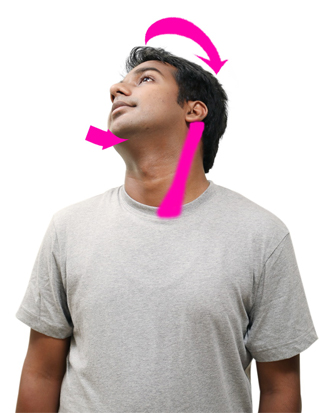
Steps for doing:
- The coloured part in being stretched.
- Neck tilted to the right side for stretching left side muscle.
- Neck slightly rotated towards the right side.
- Remember to tuck the chin and lift the left ear up for a better stretch.
- Hold the same position for 10-20 seconds, without holding your breath.
In this video, we are going to see Sternocleidomastoid muscle stretching exercise
The coloured part is being stretched as shown
The arrow indicates the direction of stretch
- The muscle is responsible for dizziness, vertigo, and imbalance.
- Symptoms refer to neck, face, head, ears, cheek, temple and eyes.
- Symptoms may include pain, numbness, hypersensitivity, altered sensation, irritability and symptoms related to compression of adjacent blood vessels and nerves.
- Commonly related to diseases such as stiff neck syndrome, Various headaches, facial pain, sore throat, imbalance, disturbed weight perception, and eye disorders.
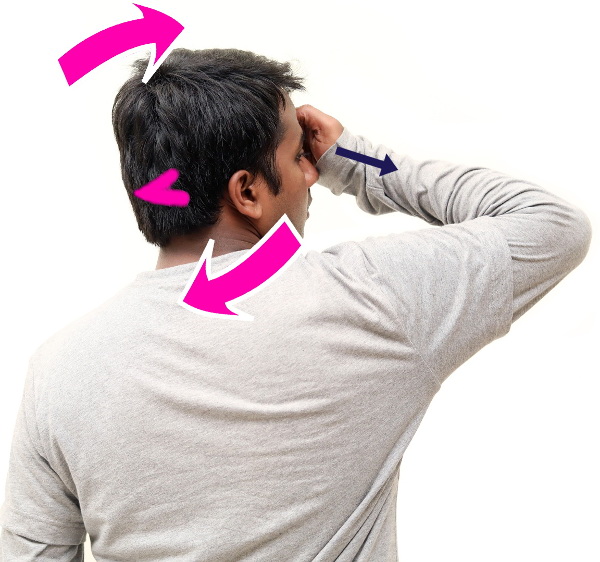
Steps for doing:
- The coloured part is being stretched.
- Tuck your chin towards chest wall.
- Push your head backward.
- Hold the same position for 10-20 seconds, without holding your breath.
In this video, we are going to see the stretching exercise of sub occipital group of muscles
The coloured part is being stretched as shown
The arrow indicates the direction of stretch
- This muscle is responsible for migraine headache.
- Symptoms refer to head and neck junction, head, and neck region.
- Symptoms may include pain, numbness, hypersensitivity, altered sensation, irritability and symptoms related to compression of adjacent blood vessels and nerves.
- Commonly related to diseases such as stiff neck syndrome, various headaches, and spinal joint dysfunction.

Steps for doing:
- The coloured part in being stretched.
- Hold your right hand behind your body.
- Pull your head towards left as shown.
- See that your left hand fully covers the right ear.
- Your left ear should touch the left shoulder.
- Keep your spine straight for better stretch.
- Hold the same position for 10-20 seconds, without holding your breath.
In this video, we are going to see upper trapezius muscle stretching exercise
The coloured part is being stretched as shown.
The arrow indicates the direction of stretch
- It is the major muscle of the body holding the head, neck, upper spine, and the shoulder.
- It is the most common cause of various headaches and various neck pain.
- It may cause symptoms involving the head, neck, upper spine, shoulder, and upper limb region.
- Symptoms may include pain, numbness, hypersensitivity, altered sensation, irritability and symptoms related to compression of adjacent blood vessels and nerves.
- Commonly related to diseases such as the stiff neck, cervical disc prolapse, TMJ dysfunction, shoulder dysfunction, cervical spondylosis, and others
 Brain and Spine Secrets
Brain and Spine Secrets